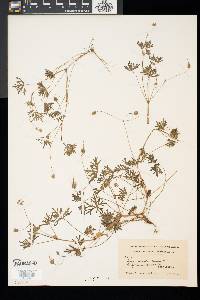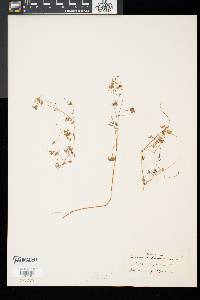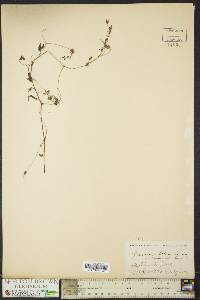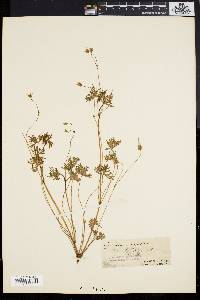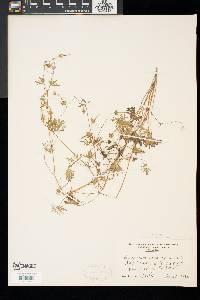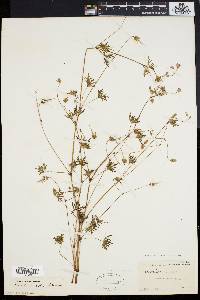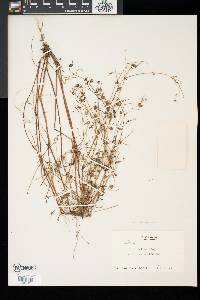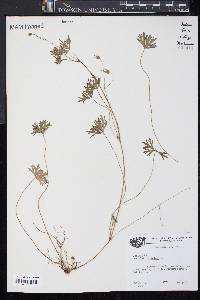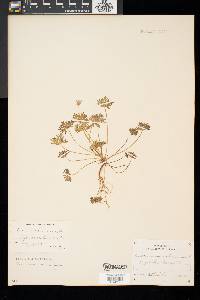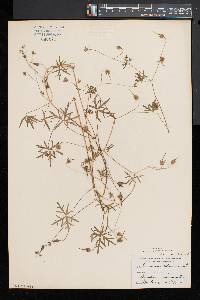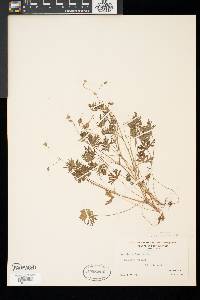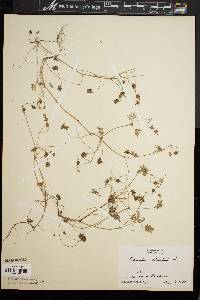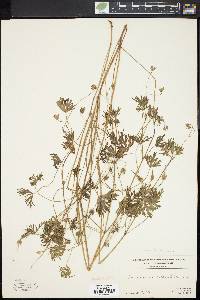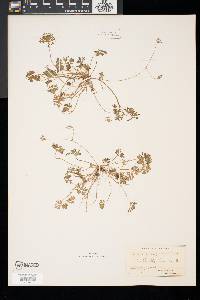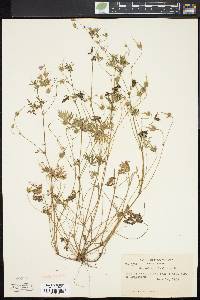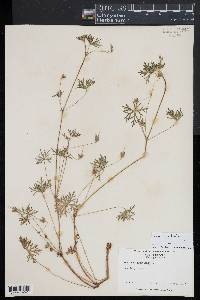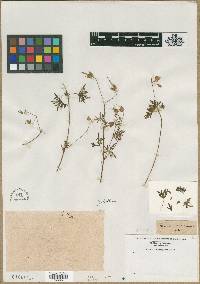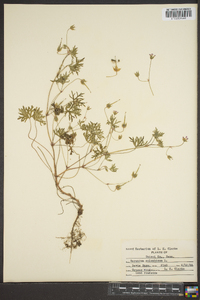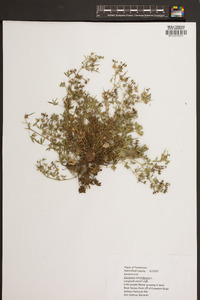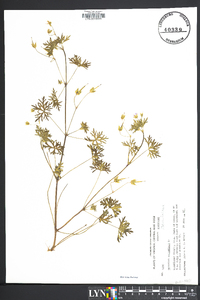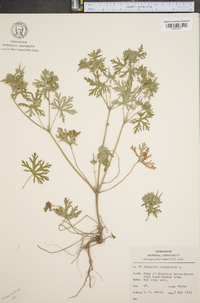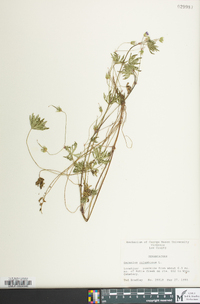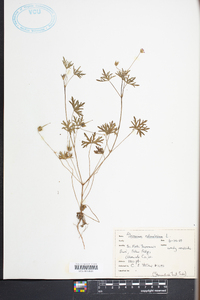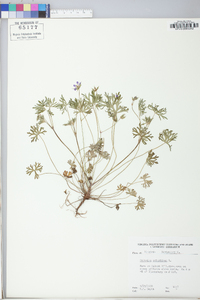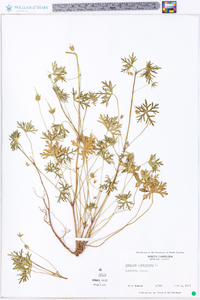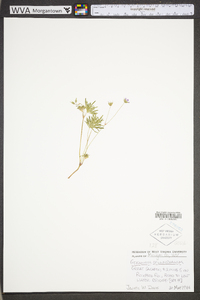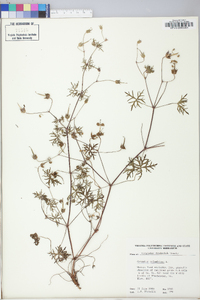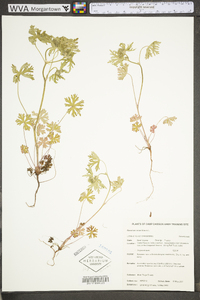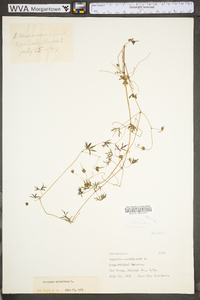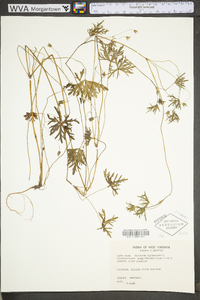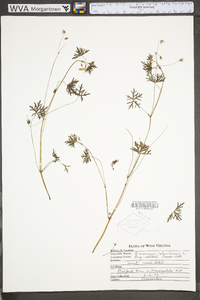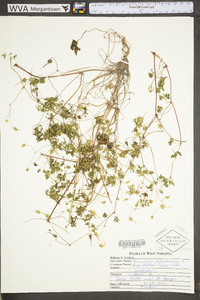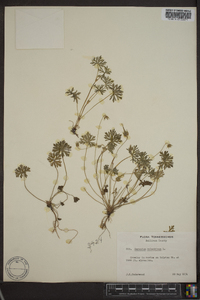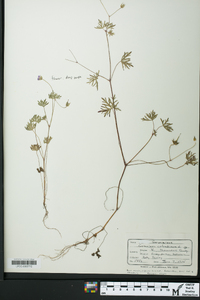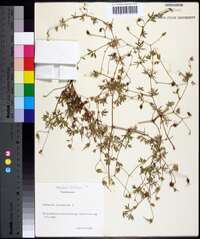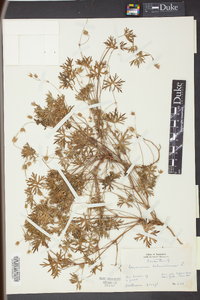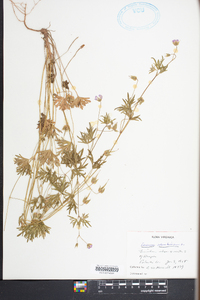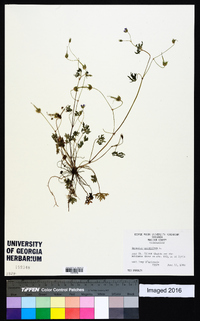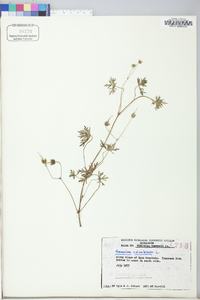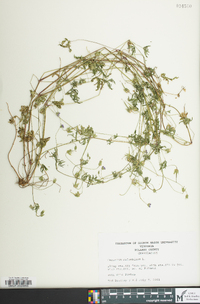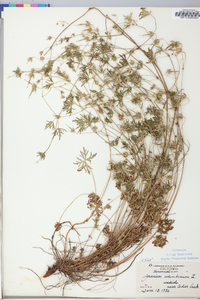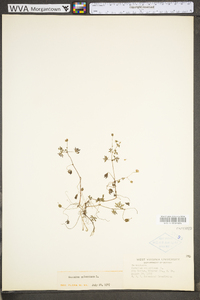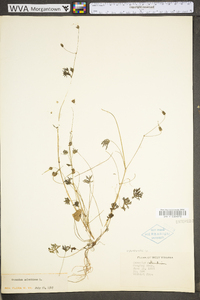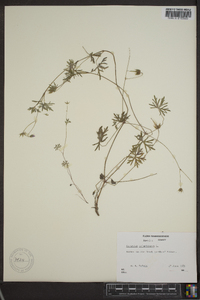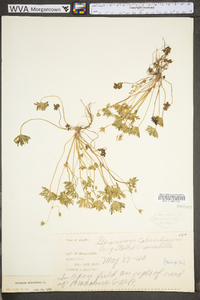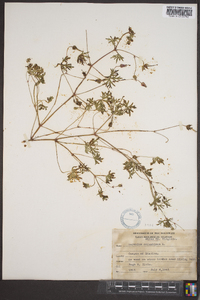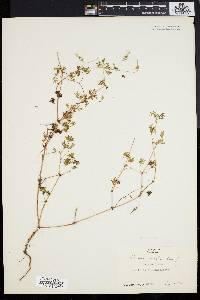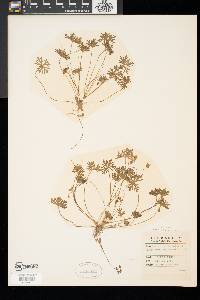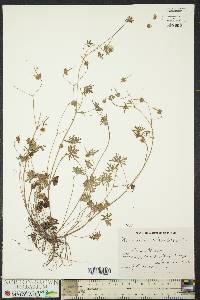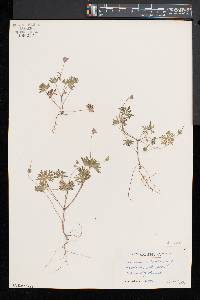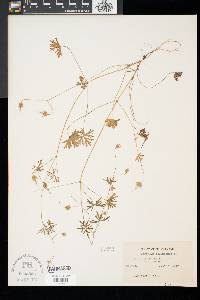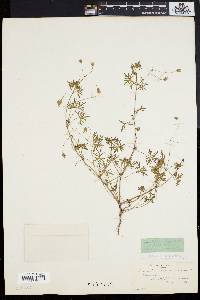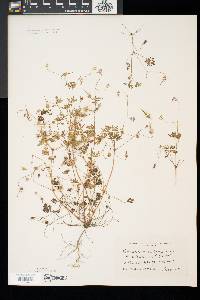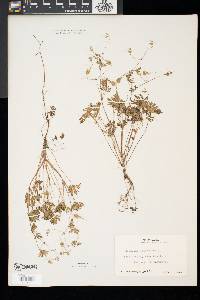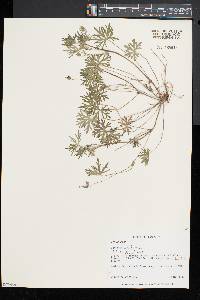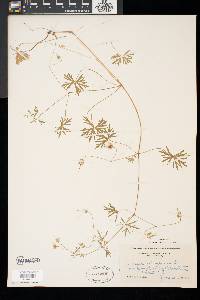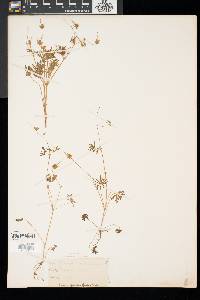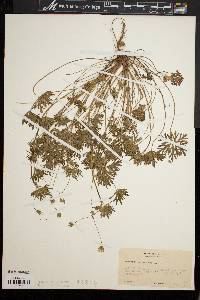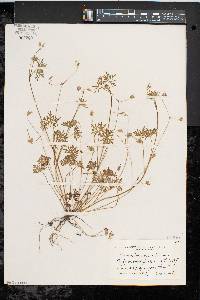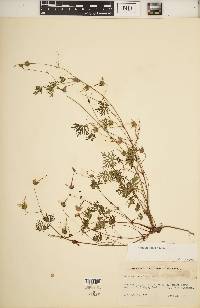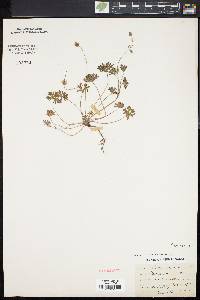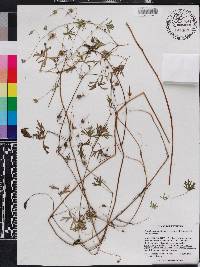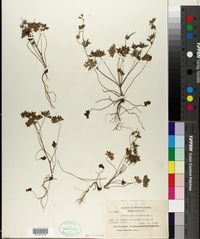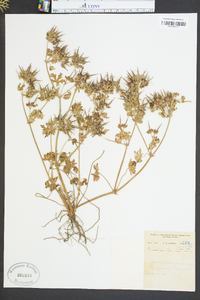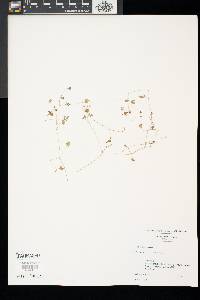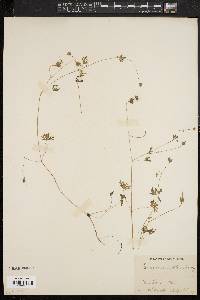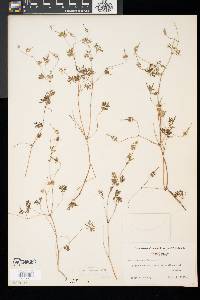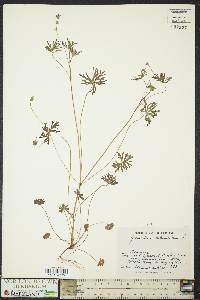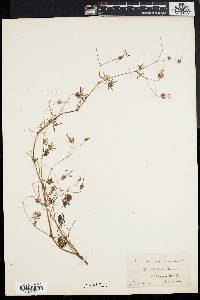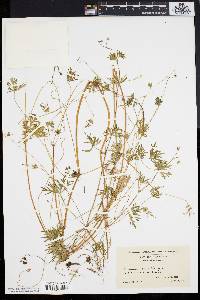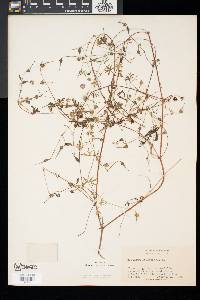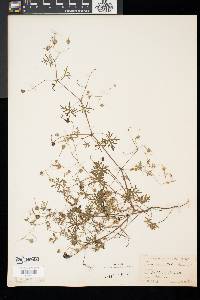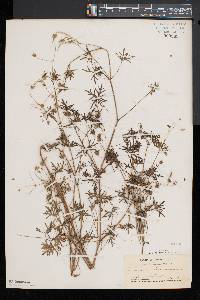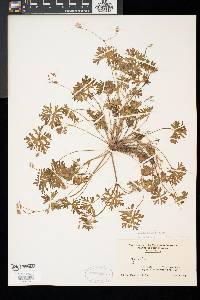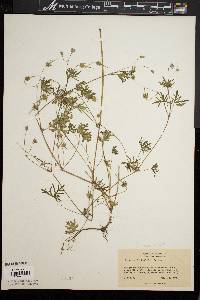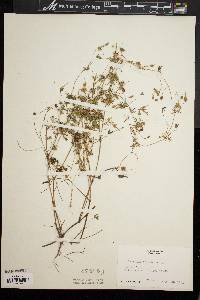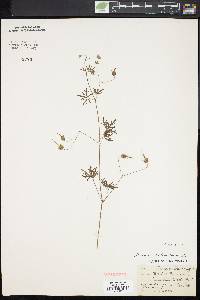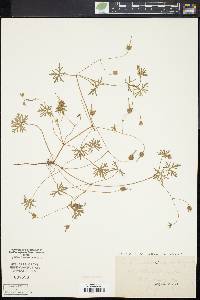
|
|
|
|
Family: Geraniaceae
Long-Stalk Crane's-Bill
|
Annual or biennial herb 10 to 60 cm tall Stem: forking with many ascending branches, usually covered with short, down-curved hairs. Leaves: basal and opposite, stalked (basal long-stalked, stem leaves with shorter stalks), 3 - 5 cm wide, kidney-shaped in outline but deeply palmately five- to seven-lobed with lobes very narrow and further linear-lobed. Flowers: pink-purple, long-stalked, small (up to 2 cm diameter), radially symmetric, and in pairs atop long, hairy, axillary stalks. The two flower stalks at the tip of each main stalk are quite long (much more than twice the length of the sepals), and covered with short, appressed, down-curved hairs. Sepals: five, alternate with petals, green, appressed-hairy (hairs point toward tip), non-glandular, 0.5 - 1.2 cm long, with an abruptly narrowed, at least 2 mm long, stiff bristle at tip. Petals: five, pinkish purple, 0.8 - 1 cm long, inversely egg-shaped with narrowed base, and notch at center of the wider, flattened to shallowly rounded tip. Next to the base of each petal there is a gland, thus making a ring of five glands alternate the petals. Stamens: ten in two series, all fertile, with filaments widened at base, and up to 1 mm long anthers. The ring of five longer stamens are aligned with the petals, while the five shorter stamens are alternate with the petals. Pistil: with a single, deeply five-lobed, superior ovary; one elongated style column; and five linear stigmas. Fruit: five, erect, mostly hairless, non-glandular, about 2.5 cm long, single-seeded, rounded base, beaked, nutlike segments surrounding remnant elongated style column of each flower. Each nutlike segment has a 4 - 5 mm long, narrowed beak at its tip, which is attached to the lower part of the style column, and then is pulled upwards by the coiling outer wall of the style column, yet stays attached to the entire fruiting structure and ejects the seed from the main body of the nutlike segment. Similar species: Geranium columbinum is very similar to the native G. bicknellii, but that species has glandular, long-hairy flower stalks, and the nutlike portion of the fruit is also obviously hairy. Frequently G. columbinum is confused with another non-native species, G. sibiricum, but that species differs by having a short rhizome, longer reflexed hairs on the stem and flower stalks, often only single flowers per stalk, shorter petals which are marked with dark veins, and hairy fruit with a much shorter apical beak (about 1 mm). Also incredibly similar is another non-native, G. dissectum, but that species often has glandular hairs present on the flower stalks and sepals, the sepal tips are shorter, the fruit is hairy, and the apical beak of the fruit is almost nonexistent. Another similar non-native species is G. thunbergii, but that species is a perennial with a stout rhizome, it has no apical bristles on the sepals, and the apical beak of the fruit is less than 1.5 mm long. Other species of Geranium with bristle-tipped sepals have the individual flower stalks less than twice the length of the sepals, and the narrowed apical beak of the fruit is less than 2 mm long. Flowering: early June to August Habitat and ecology: Introduced from Europe, this species has only been reported twice in the Chicago Region from weedy habitats of a lawn and roadside. Occurence in the Chicago region: non-native Author: The Field Museum Annual or biennial; stems several, diffusely ascending, 2-4 dm; basal lvs reniform, 3-5 cm wide, 5-7-cleft nearly to the base into deeply and narrowly cleft segments; cauline lvs similar, on shorter petioles, even the uppermost ones opposite; peduncles elongate; pedicels 2, elongate, minutely pubescent with appressed retrorse hairs; sep 5-8 mm excluding the subulate tip, antrorsely strigillose; pet purple, retuse, 8-10 mm; mature fr 2.5 cm, the stylar beak 4-5 mm, the carpel-bodies glabrous or sparsely pilose on the back, not wrinkled; 2n=18. Native of Europe, established as a weed from N.Y. to N.D., s to Ga. June-Aug. Gleason, Henry A. & Cronquist, Arthur J. 1991. Manual of vascular plants of northeastern United States and adjacent Canada. lxxv + 910 pp. ©The New York Botanical Garden. All rights reserved. Used by permission. From Flora of Indiana (1940) by Charles C. Deam This species was found in 1935 by Miss Edna Banta. It was a frequent weed in a pasture field on the Kellar farm about a mile southwest of Wirt, Jefferson County. ...... Indiana Coefficient of Conservatism: C =null, non-native Wetland Indicator Status: N/A |

